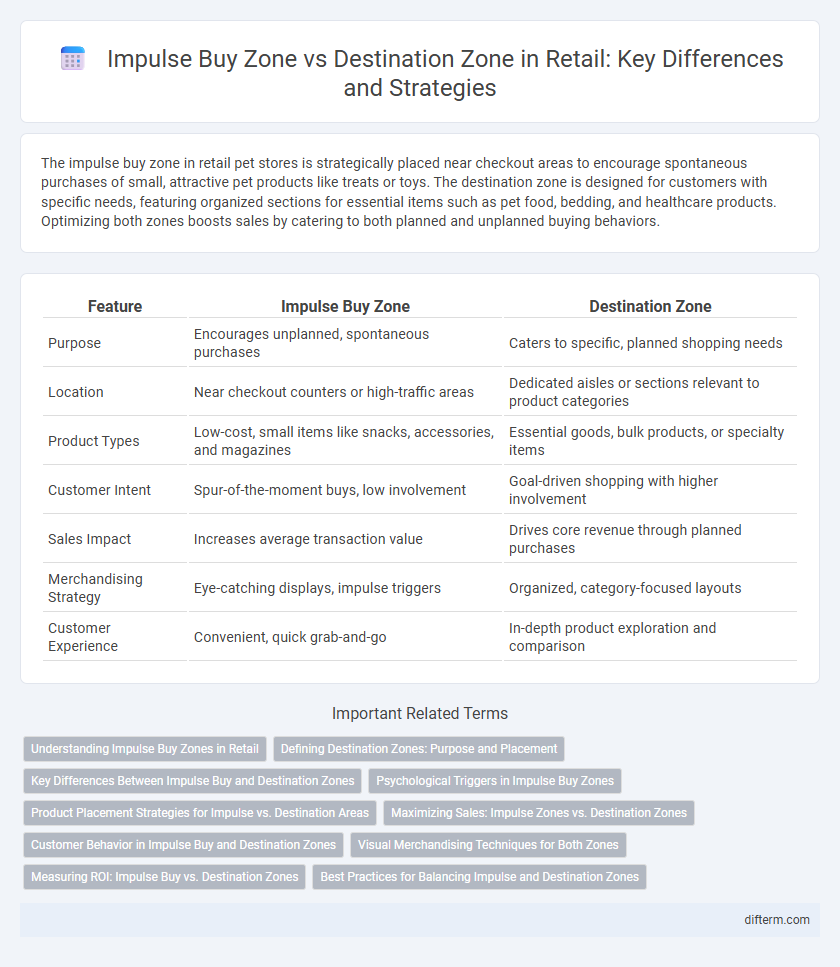The impulse buy zone in retail pet stores is strategically placed near checkout areas to encourage spontaneous purchases of small, attractive pet products like treats or toys. The destination zone is designed for customers with specific needs, featuring organized sections for essential items such as pet food, bedding, and healthcare products. Optimizing both zones boosts sales by catering to both planned and unplanned buying behaviors.
Table of Comparison
| Feature | Impulse Buy Zone | Destination Zone |
|---|---|---|
| Purpose | Encourages unplanned, spontaneous purchases | Caters to specific, planned shopping needs |
| Location | Near checkout counters or high-traffic areas | Dedicated aisles or sections relevant to product categories |
| Product Types | Low-cost, small items like snacks, accessories, and magazines | Essential goods, bulk products, or specialty items |
| Customer Intent | Spur-of-the-moment buys, low involvement | Goal-driven shopping with higher involvement |
| Sales Impact | Increases average transaction value | Drives core revenue through planned purchases |
| Merchandising Strategy | Eye-catching displays, impulse triggers | Organized, category-focused layouts |
| Customer Experience | Convenient, quick grab-and-go | In-depth product exploration and comparison |
Understanding Impulse Buy Zones in Retail
Impulse buy zones in retail are strategically positioned areas designed to encourage spontaneous purchases by leveraging high-traffic locations such as near checkout counters or store entrances. These zones showcase small, affordable, and visually appealing products that capture customer attention during moments of decision-making. Effective use of impulse buy zones increases average transaction value by enticing customers to add last-minute items to their shopping carts.
Defining Destination Zones: Purpose and Placement
Destination zones are strategically placed areas within retail stores designed to attract customers seeking specific products, ensuring they fulfill planned purchases efficiently. These zones typically house essential or high-demand items that draw targeted shopper traffic, such as fresh produce or pharmacy sections. Proper placement near store entrances or along main aisles enhances visibility and facilitates an intuitive shopping flow, reinforcing store layout effectiveness and sales performance.
Key Differences Between Impulse Buy and Destination Zones
Impulse buy zones are strategically placed near checkout counters to prompt spontaneous purchases, featuring small, low-cost items that attract customer attention through impulse triggers. Destination zones are located in areas with high foot traffic where customers intentionally seek specific products, often characterized by organized displays and product variety to satisfy planned shopping needs. The key difference lies in buyer intent: impulse zones drive unplanned purchases through proximity and visibility, while destination zones cater to deliberate, goal-oriented shopping behavior.
Psychological Triggers in Impulse Buy Zones
Impulse buy zones leverage psychological triggers such as scarcity, urgency, and sensory appeal to prompt spontaneous purchases by stimulating customers' emotional responses and perceived value. Strategic placement near checkout counters and high-traffic aisles exploits these triggers, creating a sense of immediacy and limited opportunity that can override rational decision-making. By contrast, destination zones cater to planned purchases and rely less on emotional triggers, focusing more on product information and availability.
Product Placement Strategies for Impulse vs. Destination Areas
Impulse buy zones are strategically positioned near checkout counters or high-traffic aisles to stimulate spontaneous purchases through eye-catching displays and small, low-cost items. Destination zones, located in deeper store areas where customers intentionally search for specific products, rely on organized layouts and clear signage to facilitate efficient navigation and planned shopping. Effective product placement in impulse zones emphasizes convenience and visibility, while destination zones prioritize product variety, stock levels, and category organization to enhance customer satisfaction.
Maximizing Sales: Impulse Zones vs. Destination Zones
Maximizing sales in retail requires strategic placement of products within impulse buy zones and destination zones, where impulse zones capture spontaneous purchases near checkout areas, generating high-margin sales from small, low-commitment items. Destination zones, often located in the store's back or middle sections, draw customers intentionally seeking specific products, increasing overall basket size through targeted promotions and product assortments. Optimizing these zones with data-driven insights on customer behavior boosts revenue by balancing impulse buys and planned purchases effectively.
Customer Behavior in Impulse Buy and Destination Zones
Impulse buy zones capitalize on customer spontaneity by placing small, low-cost items near checkout areas, encouraging last-minute purchases driven by visual cues and immediate gratification. Destination zones attract shoppers with a clear intent, usually housing essential or high-demand products, where customers exhibit planned behavior and deliberate decision-making. Understanding these behaviors helps retailers optimize product placement, increasing overall sales by targeting both impulsive and intentional shopping patterns.
Visual Merchandising Techniques for Both Zones
Impulse buy zones use eye-catching displays, strategic product placement, and attractive lighting to trigger spontaneous purchases near checkout counters. Destination zones rely on organized layouts, clear signage, and focused product grouping to guide customers efficiently toward high-demand items. Both zones optimize shelf height, color contrasts, and sensory cues to enhance customer engagement and drive sales.
Measuring ROI: Impulse Buy vs. Destination Zones
Measuring ROI in retail requires analyzing sales lift and conversion rates within impulse buy zones compared to destination zones. Impulse buy zones, often located near checkout areas, typically generate high-margin, low-ticket purchases with quick turnover, impacting short-term profitability. Destination zones attract planned shoppers seeking specific products, contributing to higher average transaction values and long-term customer loyalty, making ROI assessment crucial for strategic space allocation.
Best Practices for Balancing Impulse and Destination Zones
Impulse buy zones strategically place small, low-cost items near checkout areas to maximize spontaneous purchases, while destination zones house high-demand products that customers specifically seek. Effective retail layouts balance these zones by ensuring destination zones remain easily navigable and well-stocked, while impulse zones feature eye-catching displays and trending products to stimulate last-minute buying decisions. Regular data analysis on foot traffic and sales performance helps optimize product placement, enhancing overall store profitability by catering to both planned and unplanned shopper behaviors.
impulse buy zone vs destination zone Infographic

 difterm.com
difterm.com